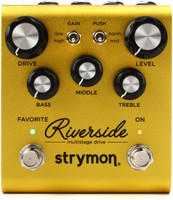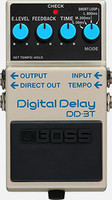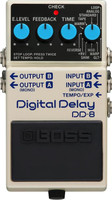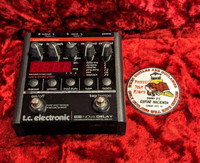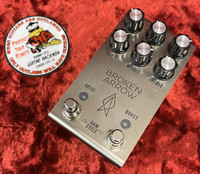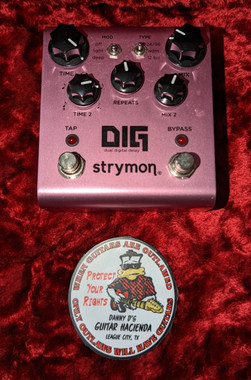 Loading... Please wait...
Loading... Please wait...Categories
- New Arrivals
- Acoustic Guitars
- Electric Guitars
- Bass Guitars
- Accessories
- Amplifiers
- Banjos
- Lap Steel
- Mandolins
- Parts
- PA Systems & Accessories
- Pedals & Effects
- Pickups
- Resonators
- Small Size Guitars
- Starter Packs
- Ukuleles
- Used
Used Strymon Dig Dual Digital Delay V1 Pedal
Our Committment to You
We want to help you find the perfect instrument the first time, feel free to give us a call at 281-338-1830 for an in-hand description of any item or come to the store front for the best guitar and guitar parts selection in Houston.
Product Description
This product has been tested by our in shop techs.
This pedal comes with the original Box.
DIG unearths the true soul of digital delay and doubles it—two simultaneous, integrated delays with the captivating rack delay voicings from the 1980s and today, for incredible expressive potential.
Effortlessly create your own world of intricate and synchronized echoes, along with hypnotic and atmospheric repeats that blur the line between delay and reverb. Stretch your sonic horizons with five musically satisfying rhythmic subdivisions and three dual delay routing options. Go from syncopated, pulsating delay patterns, to evocative, spaced-out echo trails all in a compact, pedalboard-friendly format.
Rack-mount digital delays of the ’80s ushered in a new era of audio effects. The innovative electronic designs generated the cleanest delays yet to be heard, but also created their own special and intriguing sonic characteristics. Thirty-plus years later, these sounds remain as distinctive and inspiring as ever.
DELAY 1 – The Master Delay.
Free-running delay time allows you to easily dial in delays from 20ms to 1.6s with the Time knob or Tap Tempo switch. Longer delay times lend themselves to more ambient soundscapes while doubling and slapback effects can be achieved at short delay times.
DELAY 2 – The Companion Delay.
Set the ratio between the two delays with one of five rhythmic subdivisions: triplet, eighth note, dotted eighth note, dotted quarter note, and the golden ratio. Don’t want synchronization? Engage Free Mode to disable subdivisions and allow Delay 2 to be its own independent, free-running delay. Dial in short delay times for chorus/flange sounds to run alongside Delay 1.
- Two simultaneous, integrated delays, with unique digital rack delay voicings
- Five dual delay adjustment and tone shaping knobs: Time, Time 2, Mix, Mix 2, Repeats
- One modern and two classic digital delay voicings: 24/96, adm, 12 bit
- Five rhythmic subdivisions: Triplet, Eighth, Golden Ratio, Dotted Eighth, Dotted Quarter
- Three choices for delay line modulation: Off, Light, Deep
- Five “hidden” knobs for deep dual delay control: Delay 1 Subdivision, Sync/Free Mode, Filter, Config, Delay 2 Repeats
- Selectable Free Mode disables subdivisions and synchronization
- Press and hold Circular Repeats effect
- 20ms – 1.6s delay range (40ms – 3.2s with Half Note Delay 1 Subdivision)
Set up your two delays in one of three configurations. Series is like setting up pedals in a chain on your board, feeding Delay 2 into Delay 1. Parallel will orient your delay lines so that they remain independent—Delay 1 in the left channel and Delay 2 in the right channel. With Ping Pong, each delay acts as a ping pong delay, interacting together when both Mix knobs are turned up.
- Versatile digital delay pedal that lets you conjure a wide range of iconic delay effects
- Fueled by the full power of an entire SHARC DSP chip for maximum depth and detail
- Choose from 3 digital delay styles, including ADM, 12-bit, and 24-bit/96kHz modes
- 3 delay line modulation modes provide even greater character control
- Layer 2 delay engines in serial, parallel, or ping-pong configurations
- Shape your effect with 10 parameter adjustments on 5 easily accessible knobs
- Powerful extras include a selectable Free Mode and a circular repeats function
- Take control of any parameter via any standard expression pedal
- Connect a footswitch to instantly recall your favorite preset
- Choose between true-bypass and analog-buffered trails operation



